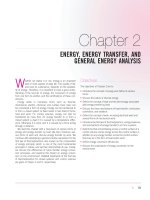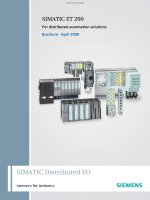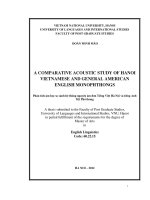Iep general brochure en
Bạn đang xem bản rút gọn của tài liệu. Xem và tải ngay bản đầy đủ của tài liệu tại đây (5.36 MB, 12 trang )
Protecting Your Process
Against Explosions
Since 1956
IEP Technologies™
The Name to Trust for Explosion Protection
IEP Technologies is the worldwide leading provider of explosion protection systems and
services. For over 60 years we have provided protection solutions that can suppress, isolate
and vent combustible dust or vapor explosions in process industries. IEP Technologies
operates globally with locations in the U.S., UK, EU, Latin America and Asia designing and
servicing systems with a dedicated team of application engineers, regional sales managers
and field engineers.
What sets IEP Technologies apart…
Unsurpassed Verification and Approvals
IEP Technologies has conducted thousands
of full-scale explosion tests to better
understand the science behind flame
propagation and verify our protection
solutions. Our products are ATEX compliant
and/or FM approved. IEP Technologies is the
only provider in the industry with Design
Calculation Tools that are ATEX approved.
This means that every design using our
Design Calculation Tools is ATEX approved.
From design to service, you can have
confidence in the solution IEP Technologies
provides.
Combustion Research Center
Our state of the art facility is fully-equipped
and dedicated to the ongoing study of
explosions and the constant advancement of
explosion protection science. Understanding
the explosibility of your product is the first
step in developing your protection solution.
Single Source Responsibility
Whether the application calls for an
integrated explosion detection and
suppression system, a venting device, a
custom isolation system, or any combination;
IEP Technologies can meet the challenge
with a turnkey solution…from design to
24-hour emergency response.
Explosion Protection Professionals
The IEP Technologies team, including our
sales representatives, field & applications
engineers and service technicians, have a
unique skill to support you. Each understands
not just the IEP Technologies product range,
but also your process and how our solutions
can help protect it.
Worldwide Service
IEP Technologies recruits, trains and retains
the finest network of Authorized IEP
Technologies Service Centers providing fast
response resulting in a minimum of disruption
to our customers’ operations. These service
centers are backed by IEP Technologies with
over 50 strategically located, factory
technicians who provide on-site technical
support to our customers.
The Anatomy of an Explosion
Why Does It Happen?
A deflagration explosion requires five
elements; fuel, oxygen, dispersion, an
ignition source and a confined space. Does
your process generate these elements?
Fuel can be a bulk material that is dispersed
as a cloud of fine particles, a flammable gas
or a volatile chemical that creates vapors.
Oxygen is readily available in most plant
processes. Ignition can be generated by a
flame, a welding arc, spontaneous
combustion, frictional or electrostatic
sparking. Finally the majority of plant
processes can provide the confined space.
Once all five elements are brought together,
the potential for an explosion can exist in
your plant.
How Does It Develop?
An explosion is a propagating combustion
wave – or deflagration – moving at less than
the speed of sound. A flame front travels
initially at slow speeds but increases velocity
quickly which forms a leading high pressure
or shock wave. Since most industrial
processes are not designed to withstand
the pressures developed in an explosion, a
rupture occurs in the process releasing a
destructive pressure shockwave and flame.
The subsequent damage can include a
much larger secondary explosion occurring
when the initial explosion disturbs dust
layers within the facility itself as well as a
post-explosion fire.
Fuel
Dispersion
Ignition Source
Oxygen
Confinement
Ignition Point
Flame Front
Pressure Wave
Cool
Compressed
Gases
3
Where Can An Explosion Strike?
Explosive Materials
As a rule, if a material can burn, under the
right conditions, it can and will explode. Any
facility that handles, stores or processes
flammable gases, liquids or solids has some
degree of explosion risk.
Dust explosions happen regularly and
with products you may not expect. Cellulose,
Fungicides, Plastics and Resins to name a
few but Chocolate, Flour, Paper and Starch
can be dusts at risk as well.
Vapors at risk cover a broad spectrum from
Acetone to Toluene with many in-between.
Explosive Environments
Conveying, processing, pulverizing or
storing of combustible materials can provide
the containment needed to elevate a fire
risk to an explosion risk within your facility.
explosion pressure [bar]
maximum explosion pressure Pmax
normal explosion development
reduced explosion pressure Pred
development of a suppressed explosion
deployment of extinguishing powder
P A = response pressure of pressure sensor
4
time t [ms]
Selecting the Proper Explosion Protection Solution
There are three basic systems types employed for explosion protection: venting, isolation
and suppression. The flow chart below uses a dust collector as a typical application to
show the process IEP Technologies engineers take to select the most appropriate system(s)
to specifically fit your application. We are always available to assist you in determining the
most suitable explosion protection approach for each of your applications.
5
Explosion Vent Panel Solutions
Relieve Explosion Pressure Safely
An IEP Technologies Explosion Vent is a relief device that ruptures at a
predetermined pressure to allow the fireball and explosive pressure to vent to
a safe area. Rupture style vents are economical to install and these highly
efficient vents fit into the walls of a process volume. They are available in a
variety of sizes, configurations and materials to ensure fast reliable operation
during an explosion event. IEP Technologies also offers a range of Flameless
Vents which are designed to quench the flame and relieve the pressure. This vent is typically
used in applications which cannot be vented to a safe, outside area. Either vent type is
typically installed in conjunction with an IEP Technologies Isolation System.
1. Protected Equipment
2. Explosion Vent Panel
2
1
3. Explosion Isolation
3
Vented explosion
Explosion Vent - GE
6
Explosion Vent - GE
Explosion Vent - KE
Explosion Vent - KER
Flameless Venting Solutions
Relieve Explosion Pressure While Quenching the Flame
In applications where explosion vent panels cannot be used due to the protected
vessel being located indoors or where venting to a safe place cannot be
accomplished, Flameless venting may provide a cost-effective alternative. IEP
Technologies offers several Flameless venting solutions designed to support a
wide range of applications. In cases where Flameless or standard venting are
not suitable, an IEP Technologies suppression system can be offered as an
alternative protection option.
1. Protected Equipment
2
1
2. Flameless Explosion Vent
3. Explosion Isolation
3
Flameless vented explosion
EVN
Flameless Vent
IV8
Flameless Vent
7
IEP Technologies Explosion Isolation Systems
Isolate Explosions – Chemically or Mechanically
IEP Technologies Isolation Systems are designed to detect an incipient
explosion and react to minimize the risk of the deflagration from traveling
between interconnected equipment within your process. The Chemical Type
isolation method discharges an explosion suppressant into pipeline/ductwork
mitigating the passage of flame and burning materials to interconnected
equipment. The Mechanical Type isolation method can be designed using either an “Active”
product such as the IEP Technologies high speed knife valve or a “Passive” product such as
our Flap Valve. Each of these provide a mechanical barrier which isolates the deflagration
event.
Active Isolation
Passive Isolation
IsoFlap® Isolation
Flap Valve
8
IsoDisc®
Isolation Valve
Infrared Detector
Ventex
Isolation Valve
IEP Technologies Explosion Suppression Systems
Detect and Suppress Explosions in Milliseconds
In a matter of milliseconds, your IEP Technologies Explosion Suppression
System is designed to detect the buildup of pressure during an explosion and
discharge an explosion suppressant into the enclosed space before destructive
pressures develop. The suppressant works by interfering with the explosion’s
reaction, by removing heat from the deflagration’s flame front and thereby
lowering its temperature below that needed to support combustion. The
explosion suppressant also creates a barrier between the unburnt combustible particles to
prevent the further transfer of heat.
1
3
4
2
1. Protected Equipment
2. Control Panel
3. Pressure Detector
4. Explosion Suppressor
eSUPPRESSOR®
MEX-3® Pressure
Detector
EX-8000 Control Panel
EX-200® Control Panel
9
IEP Technologies Spark Detection Systems
Spark Detection and Extinguishing to Prevent a More Damaging Event
Atexon spark detection and extinguishing systems by IEP Technologies
are designed to prevent dust explosions and fires by detecting sparks and
extinguishing them automatically. The small amount of extinguishing water
used, approximately five litres, will not damage filters or other production
machines. Once the danger has been removed, the system automatically
halts the extinguishing process and is ready to prevent the start of another
fire immediately. Applications for the Atexon Spark Detection system include dust extraction
systems, conveyor chutes and production machines such as planers and board presses.
These can be found in a wide range of industries including: Wood, Bioenergy, Recycling,
Paper, Food, Textile and Plastics.
Operating principle of the spark detection and fire extinguishing system
1. Spark Detectors - Detect ignition sources within a millisecond.
2. Extinguishing Unit - Extinguishes sparks and embers using a small amount of water.
3. Signal Router - Guides and monitors the extinguishing event.
4. AXN18 Control Panel - monitors the status of the system.
5. Signal Device - outputs an alarm using a siren and a strobe light.
6. Blower Controller - stops the blowers in case of overheating or a spark shower.
7. Overheat Sensing Cable - monitors the temperature of the blower bearings and the blower perimeter.
8. Pressure Booster Controller - supervises the water pump and the heat tracing cables.
9. Pressure Booster - ensures the correct delivery pressure and prevents air pockets in the extinguishing water.
Control Panel
AXN18
Extinguishing Unit
EXT11-EX
Spark Detector
SD300-EX
Booster Station
The IEP Technologies Process:
Precise Protection For Every Application
IEP Technologies has more worldwide experience protecting a wider range of
facilities against explosions than any other company. With well over 15,000
systems installed, we have developed a unique process to ensure the highest level
of protection for your facility. The IEP Technologies process includes:
Material Testing
The IEP Technologies Combustion
Research Center using recognized
test methods, such as those
published by ASTM, U.S. DOT, UN,
and others, can conduct testing to determine
the combustion properties of your process
material including dusts, liquids, and gases.
Understanding the characteristics of your
material is the first step in designing a
suitable protection solution.
Site Visit
The industry’s most experienced
Explosion Specialists review your
pre-defined hazard to gather data
that will assure a IEP Technologies
system that is matched to your specific
application.
Training
IEP Technologies offers on-site
training programs for the proper
operation and understanding of
your explosion protection system.
System Design
IEP Technologies engineers using
a proprietary Computer Modeled
System Design, develop a
protection solution that meets
your individual applications needs. We
provide key support and documentation at
this stage to ensure you understand the
overall design. Together with an on-site
design and pre-installation meeting,
our engineers will review the system
performance when employing the
recommended solution.
Installation, Commissioning and
Maintenance
Proper installation and
commissioning of the explosion
protection systems will set the
stage for the ongoing successful protection
of your process and facility.
IEP Technologies supports you from the
installation and commissioning stage
through to ongoing maintenance, and any
emergency service/spare part needs you
may have.
The Next Step
You can’t afford to let an explosion threaten your facility. Let us work with you to
keep industrial explosions from impacting your bottom line. Call IEP Technologies
today.
Europe
IEP Technologies - Austria
(HOERBIGER Safety Solutions)
Tel. +43 1 2244 0
IEP Technologies - Italy
(HOERBIGER Safety Solutions)
Tel. +39 045 2370762
IEP Technologies - Belgium
(HOERBIGER Safety Solutions)
Tel. +49 2102 5889 0
IEP Technologies - Sweden
(HOERBIGER Safety Solutions)
Tel. +46 70 564 3306
IEP Technologies - Finland
Tel. +358 10 325 358 0
IEP Technologies – Switzerland
Tel: +41 62 207 10 10
IEP Technologies – France
Tel: +33 1 5803 3980
IEP Technologies – Turkey
Tel: +90 232 484 4412
IEP Technologies – Germany
Tel: +49 2102 5889 0
IEP Technologies – UK
Tel: +44 1242 283 060
North & South America
IEP Technologies – USA
Tel: +1-855-793-8407
IEP Technologies – Latin America
(HOERBIGER Safety Solutions)
Tel: +55 (11) 4446 7400
Asia
IEP Technologies – China
(HOERBIGER Safety Solutions)
Tel: +86 21 6485 0855 Ext 8211
IEP Technologies – Korea
(HOERBIGER Safety Solutions)
Tel: +82 10 2579 8077
IEP Technologies – South East Asia
(HOERBIGER Safety Solutions)
Tel: +65 6890 0770
www.IEPTechnologies.com
417EN-23.7









